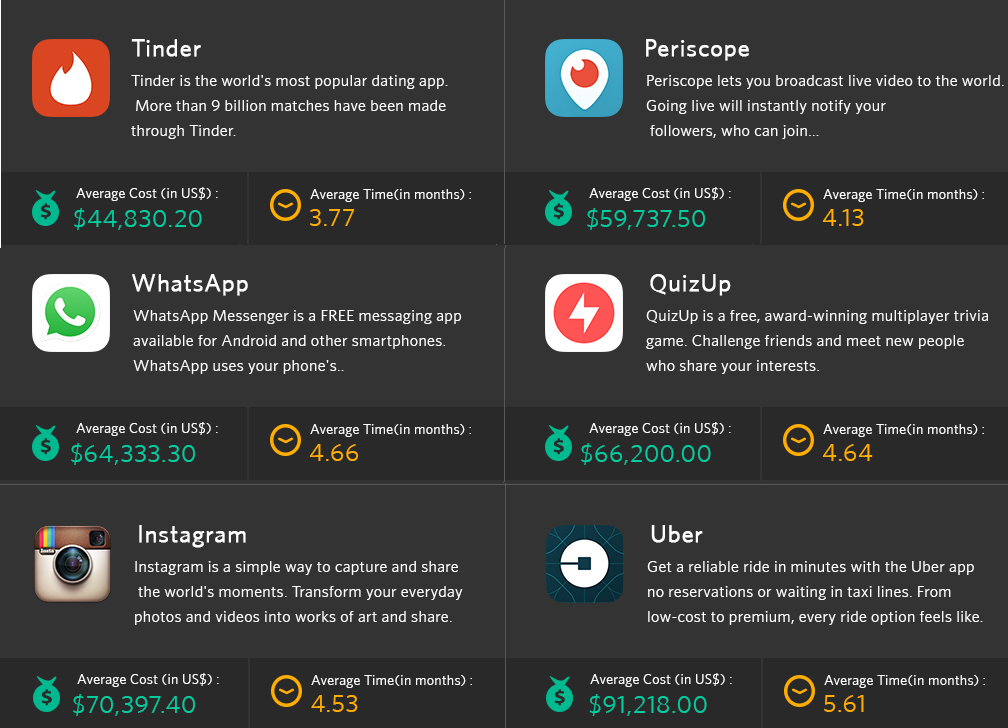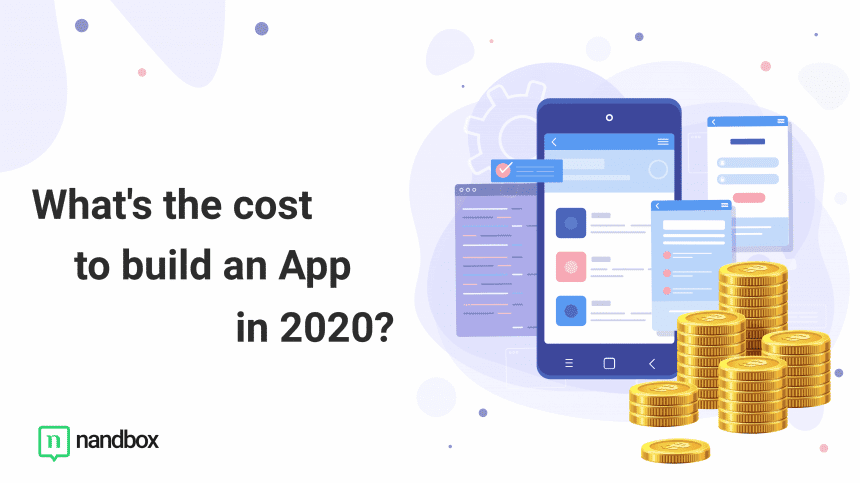How Much Does It Cost to Develop a Mobile App in 2020?
In 2020, mobile apps will be the primary digital solution for businesses and communities, tackling social distancing, lockdowns, curfews, and economic crises evoked by the Coronavirus pandemic. This crisis has raised a compelling need to build mobile apps faster and easier than traditional approaches while at the same time meeting the limited budget in these uncertain times. In its 2018 research, “How much does it cost to create an app?” GoodFirms has announced rough estimates of the app development cost for different types of mobile apps. The research states that the cost of making a mobile app with simple features ranges from $40,000 to $60,000, whereas the price can reach $100,000 as you add more complicated features like map tracking or video calling.
How Do You Set Your App Development Budget?
The first thing to keep in mind is that the cost is ongoing and not a one-time payment. That’s why a flexible budget is necessary to pay for the ongoing support and maintenance costs for both the app and it’s IT infrastructure; it’s crucial to maintain the app with each new Android and iOS update.
This article will help you make the best decision without taking exuberant risks during the uncertain times ahead. In the following lines, you will get an overview of the cost of app development, what impacts it, and a highlight of the nandbox App Builder approach to creating future-ready, native mobile apps with minimum risks.
What Does It Take to Develop an App Like Instagram or Uber?
If you have joined the global club of potential app clients, you will encounter several ways and prices to develop your app. You can outsource your app creation process, develop it in-house, or build it yourself using a no-code App Builder.

GoodFirms has estimated in its same 2018 survey that “a feature-rich, highly complex app like Instagram or Uber would ideally cost anywhere between $70,000 and $100,000.” On the other hand, no-code app builders can now generate apps that emulate those giants at a fraction of this cost and on a monthly subscription basis—a typical SaaS (Software as a Service) model.
Why Is the Cost of Making a Mobile App Intangible?
Not only the number of features, functionalities, and technology used in building the app affect its costs. It also depends on the type of app vendor, whether freelancers, nearshore, or offshore app creation companies. But even between the no-code app builders, the generated app’s quality and performance differ a lot from one to the other.
In 2015, Clutch.co surveyed 12 leading mobile app development companies to estimate a median cost of app development. The survey estimated that the initial development cost varies between $37,913 and $171,450, and could climb up to $500,000 or higher.
The survey has also broken down this cost range enigma according to the common hourly rates in the U.S. provided at that time in 2015. It states: “The calculated median cost at $100/hour for iPhone app development is $25,275.00 to $114,300.00. The median cost at a higher rate of $150/hour (the current average U.S. development rate) is $37,912.50 to $171,450.00. The maximum cost figures at $100/hour and $150/hour, respectively, were $485,000.00 and $727,500.00.”
However, if you develop your app in-house, get prepared for a whole different budget. Because then, you will need to hire a team of developers, or maybe two, in case you want to run a native app for Android and iOS, together with a team of testers and designers. That’s beside the running costs of devices, system integrations, and servers.
What Impacts the App Development Cost and Timeline?
Making an app in 2020 is no longer a single-lane street; you can choose to have your app developed for you in return for the development cost before running your app. Otherwise, you can build your app using an App builder and pay a minor monthly subscription that allows you to keep your budget in line with your app’s success.
WhatsApp took around 5 months in the development phase and reached an average cost of $64,333, as estimated by the GoodFirms’ 2018 research.
The initial app development phase mainly depends on three pillars:
- The design and features you want in your app
- The technology your app supports: Android, iOS, or both
- How will you build your app?
The Clearer You Can Describe Your Idea, the Less Time and Money Your App Development Will Take
Before building your app, you need to shape and design your business idea as a mobile app that provides a solution. This step is simple yet crucial. Doing it right will cut your timeline to two or three weeks.
All you need to do at this step is highlight what your app users will be able to do on your app.
Therefore, you will help your app makers understand your requirements better, and hence they can deliver your app faster. You can even make it much easier for them if your app idea is similar to that of a popular giant. But make sure that your idea fits your target audience so that you can serve the right customers.
Design and Features
First, you will need to enlist the features of your prospect app and prioritize them, after which your vendor may take around two to three weeks to set specifications and design your app’s pages.
Accordingly, your vendor should build and deliver a minimum viable app (MVP), which might take from 6 to 16 weeks depending on the required features. This MVP will give you a basic overview of your app’s user experience, capabilities, and performance. Speaking of performance, the technology used in building your app affects the cost and time it takes to a great extent.
Native, Hybrid, or Cross-Platform?
Native app development provides the best performance and the best visual experience for app users and can be essential if you’re looking to use many device sensors or processing capabilities, or even if you’re planning a unique experience for your users that differs from one platform to the next.
For Hybrid and Cross-Platform development, you’ll have one app code that generates two apps, one for each platform. Although this sounds appealing, it offers far less customization, many visual issues from one phone to the next, and usually degrades performance over time.
In-house, Outsourcing, or App Builders?
Traditionally, mobile app development is done in two main ways: either “let’s have a team for Android and a team for iOS, each creating their respective native app,” or “let’s have one team create one Hybrid/Cross-platform app that can run on both platforms and save money and time.” However, it’s not that easy.
Hiring a full in-house team might not be the best decision to make in terms of risks, especially in the time of coronavirus. Also, opting for a mobile app development company will require you to sacrifice 3–6 months on average, besides a small fortune, to get your app ready to use. And keep in mind the different time zones that hinder the ease of communication.
Why Don’t You Build the App Yourself? No Coding Is Needed!
App Builders, on the other hand, are not all the same. Most of them provide quick hybrid apps that can present a single business entity in a similar way to a static business website, with minor capabilities. But some others have grown into building native mobile apps in five clicks, granting two native apps, as if you have two development teams without the cost and time factor, and with advanced features like map tracking, commerce, and voice and video calling.
nandbox App Builder enables you to build and publish native mobile apps in minutes, with no coding knowledge. With a simple drag-and-drop, you can add all the features you need straight to your Native App. Driven by robust Canadian technologies, nandbox also creates apps for Shopping, Schools and Universities, Sports Clubs, and TV and Media channels.
What Makes nandbox Different?
The app creator from nandbox supports a myriad of integrations and features that range from instant messaging, video calling, map tracking, and more. That’s beside a full e-commerce module that enables you to build a shopping app with multiple stores and out-of-the-box mobile payment options.
Driven by robust Canadian technologies, nandbox supports creating full School and University Apps, Shopping Apps, Sports Club Apps, and Apps for TV and Media Channels.
With nandbox App Builder, your app will cost a fraction of the aforementioned figures starting from $49/month.
You don’t pay for the upfront development costs, devices for testing, or hosting infrastructure, but a monthly subscription, preceded by a 7-day free trial on all plans. And if you want to give your app further customizations, schedule a free call with nandbox team and get your app published on the App Store and Google Play within days.
The digital market is full of varieties of talents, qualifications, and experiences. These factors and more will affect your app’s development cost and quality. But in today’s ambiguous economic situation, a good decision will take a bunch of risks along the way. If you’re staying home or struggling with business challenges, try nandbox and let your business go mobile with minimum risks and the best quality.



